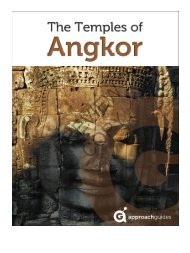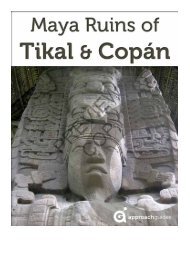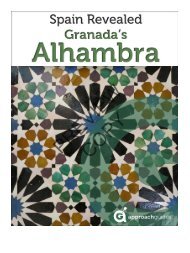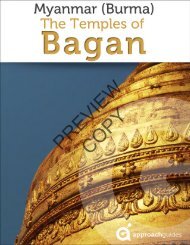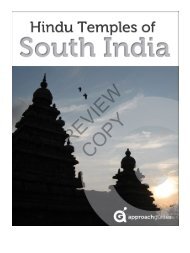The Temples of Bangkok - Approach Guides
The Temples of Bangkok - Approach Guides
The Temples of Bangkok - Approach Guides
Create successful ePaper yourself
Turn your PDF publications into a flip-book with our unique Google optimized e-Paper software.
along its length.<br />
• Vajra (pink highlights in Fig. 14). <strong>The</strong> prang is topped by Indra’s weapon, the thunderbolt<br />
(vajra), symbolic <strong>of</strong> shattering illusion; when illusion is cast aside, the believer is able to<br />
achieve enlightenment and join the Buddha in his mountain residence at the top <strong>of</strong> Mount<br />
Meru. <strong>The</strong> use <strong>of</strong> a vajra is a Thai innovation, as Khmer prangs were topped with ribbed<br />
fruits and pot finials.<br />
• Rising tiers. <strong>The</strong> rising, horizontally tiered terraces <strong>of</strong> the tower are less emphasized than<br />
on Khmer prototypes, in order to stress greater vertical, upward momentum.<br />
• Medial arched niches (red highlights in Fig. 14). <strong>The</strong> cardinal points on each ascending<br />
level <strong>of</strong> the prang have medial arched niches that typically contain images <strong>of</strong> guardian figures<br />
or Buddhas. This is consistent with Khmer precedent.<br />
• Antefixes (blue highlights in Fig. 14). Antefixes sit in the redented (cutout) corners <strong>of</strong> the<br />
tower and serve a dual purpose: (a) they smooth out the redentations, thereby affording the<br />
tower the appearance <strong>of</strong> a more perfectly round plan; and (b) they provide a simple decoration.<br />
<strong>The</strong>se antefixes are generally simpler and less prominent than those <strong>of</strong> Khmer prototypes.<br />
• Internal shrine (green highlights in Fig. 14). A Buddha shrine sits inside, directly underneath<br />
the tower.<br />
• Square, redented base (redentations marked with yellow highlights in Fig. 14). <strong>The</strong> prang<br />
tower sits on a redented, square base, <strong>of</strong>ten consisting <strong>of</strong> several stepped terraces.<br />
• Quincunx arrangement. <strong>The</strong> Khmer’s quincunx arrangement — a central prang surrounded<br />
by four smaller prangs — was used frequently, especially in Ayutthaya.<br />
<strong>The</strong> Thai Prang: Transformation over Time<br />
While the prang is a persistent feature throughout all periods, its appearance changes quite meaningfully<br />
over time, moving progressively away from the earliest Khmer prototype.<br />
Sukhothai period prang<br />
Sukhothai prangs most closely resemble those <strong>of</strong> the Khmer. <strong>The</strong>y sit on modest, simply redented<br />
bases, with prominent antefixes; a Buddha shrine sits under the prang, accessed by a single entrance.<br />
Good examples <strong>of</strong> this style are found at Wats Phra Phai Luang (see Fig. 15) and Si Sawai,<br />
both <strong>of</strong> which are pr<strong>of</strong>iled individually in this guidebook.



